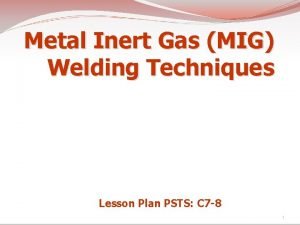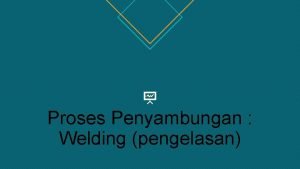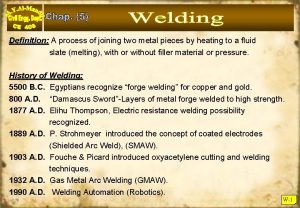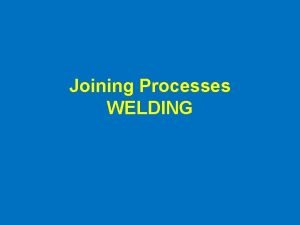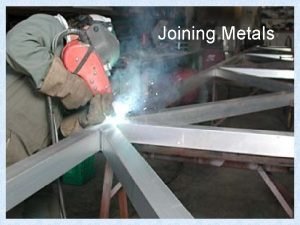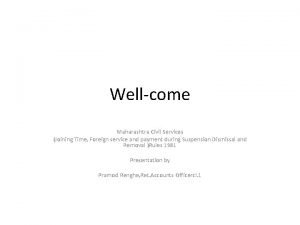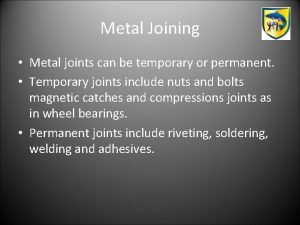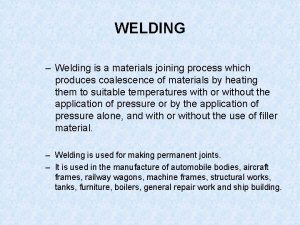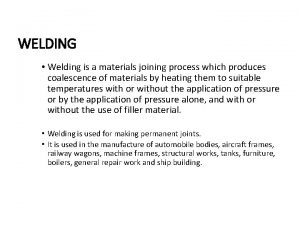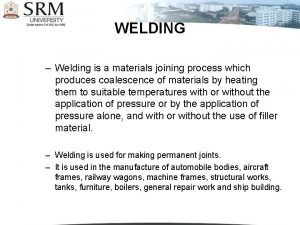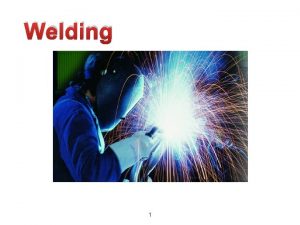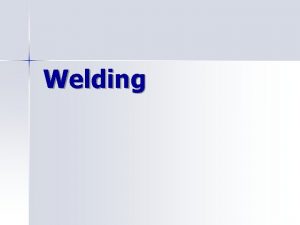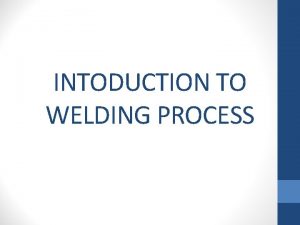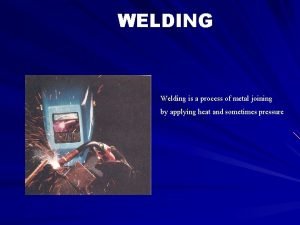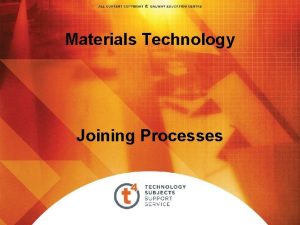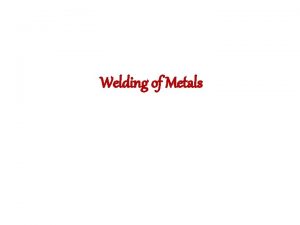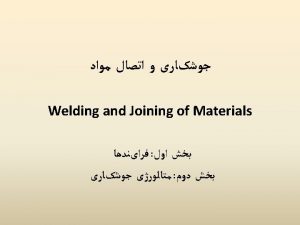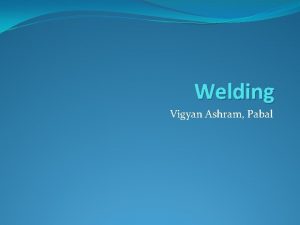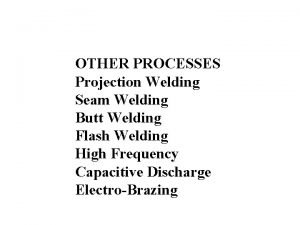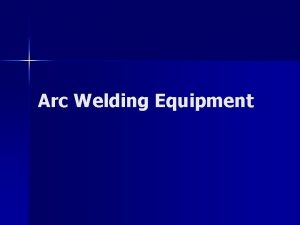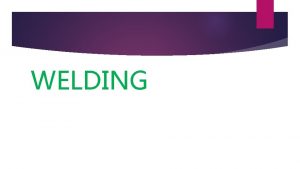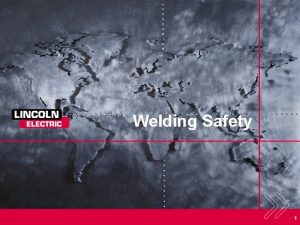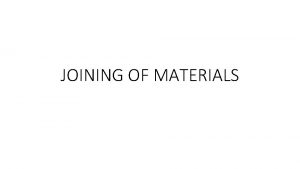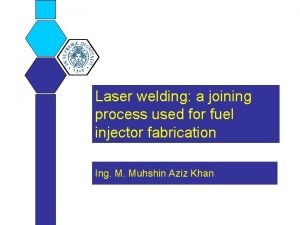WELDING Welding is a materials joining process which























- Slides: 23

WELDING – Welding is a materials joining process which produces coalescence of materials by heating them to suitable temperatures with or without the application of pressure or by the application of pressure alone, and with or without the use of filler material. – Welding is used for making permanent joints. – It is used in the manufacture of automobile bodies, aircraft frames, railway wagons, machine frames, structural works, tanks, furniture, boilers, general repair work and ship building.

TYPES • Plastic Welding or Pressure Welding • The piece of metal to be joined are heated to a

CLASSIFICATION OF WELDING PROCESSES Welding Processes (i) Arc Welding (ii) Gas Welding (iii) Resistance Welding (iv)Thermit Welding (v)Solid State Welding (vi) Newer Welding (vii) Related Process Carbon arc Oxy-acetylene Butt Spot Seam Friction Electron-beam Brazing Metal arc Metal inert gas Air-acetylene Projection Ultrasonic Laser Soldering Tungsten inert gas Oxy-hydrogen Percussion Diffusion Oxy-acetylene cutting Explosive Arc cutting Plasma arc Submerged arc Electro-slag Hard facing

CLASSIFICATION OF WELDING PROCESSES: (i). Arc welding • Carbon arc • Metal inert gas • Tungsten inert gas • Plasma arc • Submerged arc • Electro-slag (ii). Gas Welding • • • Oxy-acetylene Air-acetylene Oxy-hydrogen (iii). Resistance Welding • Butt • Spot • Seam • Projection • Percussion (iv)Thermit Welding (v)Solid State Welding • Friction • Ultrasonic • Diffusion • Explosive (vi)Newer Welding • Electron-beam • Laser (vii) Related Process • Oxy-acetylene cutting • Arc cutting • Hard facing • Brazing • Soldering

ARC WELDING – Uses an electric arc to coalesce metals – Arc welding is the most common method of welding metals – Electricity travels from electrode to base metal to ground

ARC WELDING • Equipments: A welding generator (D. C. ) or Transformer (A. C. ) • Two cables- one for work and one for electrode • Electrode holder • Electrode • Protective shield • Gloves • Wire brush Chipping • Hammer • Goggles •

METAL ARC WELDING

CARBON ARC WELDING

ARC WELDING � Advantages Most efficient way to join metals Ø Lowest-cost joining method Ø Affords lighter weight through better utilization of materials Ø Joins all commercial metals Ø Provides design flexibility Ø Limitations Ø Manually applied, therefore high labor cost. • Ø Need high energy • causing danger Ø • Not convenient for disassembly. Ø Defects are hard to detect at joints.

COMPARISON OF A. C. AND D. C. ARC WELDING Alternating Current (from Transformer) � More efficiency � Power consumption less � Cost of equipment is less � Higher voltage – hence not safe � Not suitable for welding non ferrous metals � Not preferred for welding thin sections � Any terminal can be connected to the work or electrode Direct Current (from Generator) � Less efficiency � Power consumption more � Cost of equipment is more � Low voltage – safer operation � Suitable for both ferrous non ferrous metals � Preferred for welding thin sections � Positive terminal connected to the work Negative terminal connected to the electrode

GAS WELDING • Sound weld is obtained by selecting proper size of flame, filler material and method of moving torch • The temperature generated during the process is 33000 c • When the metal is fused, oxygen from the atmosphere and the torch combines with molten metal and forms oxides, results defective weld • Fluxes are added to the welded metal to remove oxides • Common fluxes used are made of sodium, potassium. Lithium and borax. • Flux can be applied as paste, powder, liquid. solid coating or gas.

GAS WELDING EQUIPMENT. . . 1. Gas Cylinders Pressure Oxygen – 125 kg/cm 2 Acetylene – 16 kg/cm 2 2. Regulators Working pressure of oxygen 1 kg/cm 2 Working pressure of acetylene 0. 15 kg/cm 2 Working pressure varies depends upon the thickness of the work pieces welded. 3. Pressure Gauges 4. Hoses 5. Welding torch 6. Check valve 7. Non return valve

OXY-ACETYLENE WELDING

TYPES OF FLAMES… • The neutral flame is obtained when the mixed torch gas consists of approximately one volume of oxygen and one volume of acetylene. (32000 c) • It is obtained by gradually opening the oxygen valve to shorten the acetylene flame until a clearly defined inner cone is visible • The neutral flame has a one-to-one ratio of acetylene and oxygen. It is generally preferred for welding. • The neutral flame has a clear, welldefined, or luminous cone indicating that combustion is complete. • Used for welding steels, aluminium, copper and cast iron

TYPES OF FLAMES… Oxidizing welding flames are produced when slightly more than one volume of oxygen is mixed with one volume of acetylene If more oxygen is added, the cone becomes darker and more pointed, while the envelope becomes shorter and more fierce is called Oxidizing flame It Has the highest temperature about 34000 c Used for welding brass and brazing operation

TYPES OF FLAMES ØReducing or carburizing welding flames are obtained when slightly less than one volume of oxygen is mixed with one volume of acetylene (30000 C) This flame is obtained by first adjusting to neutral and then slowly opening the acetylene valve until an acetylene streamer or “feather” is at the end of the inner cone The reducing or carburizing flame can always be recognized by the presence of three distinct flame zones. There is a clearly defined bluish-white inner cone, white intermediate cone indicating the amount of excess acetylene, and a light blue outer flare envelope

GAS CUTTING… Automatic Gas Cutting Manual Gas Cutting

WELD JOINTS

BRAZING AND SOLDERING • Brazing Ø It is a low temperature joining process done below the melting point of the base metal. Ø It is performed at temperatures above 840º F and it generally affords strengths comparable to those of the metal which it joins. Ø It is achieved by diffusion without fusion (melting) of the base Brazing can be classified as ØTorch brazing Ø Dip brazing Ø Furnace brazing Ø Induction brazing


ADVANTAGES & DISADVANTAGES Advantages Very thin metals can be joined � Can be used for thin sheet metal sections � Metals with different thickness can be joined easily � In brazing thermal stresses are not produced in the work piece. Hence there is no distortion � Using this process, carbides tips are brazed on the steel tool holders � • Disadvantages � � � Dissimilar metals which cannot be welded can be joined by brazing Brazed joints have lesser strength compared to welding Joint preparation cost is more

SOLDERING Ø It is a low temperature joining process. Ø It is performed at temperatures below 840ºF for joining. Ø Soldering is used for, Sealing, as in automotive radiators or tin cans Ø Electrical Connections Ø Joining thermally sensitive components Ø Joining dissimilar metals

 Welding disadvantages
Welding disadvantages Welding lesson plans
Welding lesson plans Proses joining
Proses joining Process of joining two metals
Process of joining two metals Forge welding diagram
Forge welding diagram Join
Join Go noodle cant stop the feeling
Go noodle cant stop the feeling 5 examples of useful and harmful materials
5 examples of useful and harmful materials Natural materials and man made materials
Natural materials and man made materials What is adopting materials
What is adopting materials Direct materials budget with multiple materials
Direct materials budget with multiple materials Pipe to plate weld symbol
Pipe to plate weld symbol Joining methods of wood
Joining methods of wood Mcsr joining time rules in marathi
Mcsr joining time rules in marathi Video platform
Video platform Welcome and thank you for joining us
Welcome and thank you for joining us Reproductive system vocabulary
Reproductive system vocabulary Rafsanjani secondary school
Rafsanjani secondary school What is group dynamics in organisational behaviour
What is group dynamics in organisational behaviour Run together sentences
Run together sentences Difference between
Difference between Concept of ob
Concept of ob Temporary joining methods
Temporary joining methods Conjunction for example
Conjunction for example

